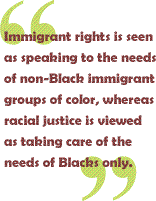| |
|
|
Black
Immigrants are Deported in Higher Numbers than Asian and Middle
Eastern Immigrants: Reconsidering Immigrant Rights' Challenge
to 'Racial Justice' Work

 In
the aftermath of 9-11, an agenda calling for immigrant rights
organizing and racial justice work to come together has become
popular in social justice circles. Calls for coalition between
the two camps were promoted before 9-11, but began to gain more
momentum (and funding) after 9-11. These gestures of "solidarity"
were mostly heard from immigrant rights advocates, who used
liberal political magazines, conferences, their newsletters,
and other public forums to argue that racial justice politics
could no longer ignore immigrants now that immigrants were becoming,
according to some, the main victims of racial profiling and
the prison system. In
the aftermath of 9-11, an agenda calling for immigrant rights
organizing and racial justice work to come together has become
popular in social justice circles. Calls for coalition between
the two camps were promoted before 9-11, but began to gain more
momentum (and funding) after 9-11. These gestures of "solidarity"
were mostly heard from immigrant rights advocates, who used
liberal political magazines, conferences, their newsletters,
and other public forums to argue that racial justice politics
could no longer ignore immigrants now that immigrants were becoming,
according to some, the main victims of racial profiling and
the prison system.
Some immigrant rights advocates pointed out that immigrant rights
work needed to have an analysis of state violence and therefore
make coalition with racial justice movements, which had already
been focusing on policing and prisons. And some racial justice
folks publicly spoke to the need for their camps to reach out
to immigrants. Indeed, it was only these sound bites – of racial
justice folks publicly chastising themselves and their kin –
that seemed to get any press in liberal political publications.
 Yet
this distinction between racial justice and immigrant rights
was grounded in assumptions of which immigrants were being targeted
by the state. Racial justice has long been coded as Black, meaning
that we assume racial justice is justice for Blacks only. Immigrant
rights, therefore, is often juxtaposed in opposition to racial
justice issues, or issues that are connected with Blacks. Immigrants
are racialized as Brown (Mexican, Central American and South
American) or as Asian or Middle Eastern (in most INS data, the
two regions are actually considered under a broad "Asian"
category that includes 39 nationalities). In other words,
immigrant rights is seen as speaking to the needs of non-Black
immigrant groups of color, whereas racial justice is viewed
as taking care of the needs of Blacks only. Yet
this distinction between racial justice and immigrant rights
was grounded in assumptions of which immigrants were being targeted
by the state. Racial justice has long been coded as Black, meaning
that we assume racial justice is justice for Blacks only. Immigrant
rights, therefore, is often juxtaposed in opposition to racial
justice issues, or issues that are connected with Blacks. Immigrants
are racialized as Brown (Mexican, Central American and South
American) or as Asian or Middle Eastern (in most INS data, the
two regions are actually considered under a broad "Asian"
category that includes 39 nationalities). In other words,
immigrant rights is seen as speaking to the needs of non-Black
immigrant groups of color, whereas racial justice is viewed
as taking care of the needs of Blacks only.
Not only does the common juxtaposition of immigrant rights versus
racial justice promote the distorted yet highly popular image
of Blacks as politically selfish, it is also a (false) distinction
not grounded in the reality of who is racially profiled for
deportation. Looking
at INS data of immigrant deportations from 1993-2002, we actually
see several trends that indicate immigrant rights agendas are
based in some misguided assumptions of which immigrants are
being routinely targeted by the state.
First, despite publicized reports inferring otherwise, the total
number of immigrant deportations – or the forced removal of
an immigrant to another country – are actually down after 9-11.
What has probably increased is immigrant detention, for which
numbers are more difficult to get given the Department of Justice's
unwillingness to release definitive figures. Second, after 9-11,
there was not a stark increase among South Asians and Middle
Easterners getting deported, or among those nationalities identified
as "Muslim." Third, Black immigrants (Caribbean or
African nationalities) and Brown immigrants (Mexican, Central
American and South American nationalities) had significantly
higher numbers of deportations compared to White (European nationalities)
and Asian nationalities (which includes Middle Eastern nationalities)
before and after 9-11.
To put it simply, Black immigrants have higher numbers of deportations
than Asian, Middle Eastern or White immigrants. For example,
in 2002, there were 8,921 total deportations of Black immigrants,
whereas there were only 3,090 total deportations for Whites
and 4,317 total deportations for Asians and Middle Easterners.
Overall, this trend is consistent from 1993-2002.

While
it is not surprising that Brown immigrants, especially those
from Mexico, Guatemala, El Salvador, and Honduras, are targeted
by the state – given the large amounts of money pumped into
Border Patrol for staffing and surveillance – the targeting
of Black immigrants by the INS does not tend to receive as much
attention among immigrant rights folks. Yet Black immigrants,
particularly Dominicans, Jamaicans and Haitians, have relatively
high rates of deportations. And the number of Black immigrant
deportations does not include South Americans (such as Colombians,
Brazilians and Guyanese, who, relative to other South Americans,
have high deportation rates), many of whom may be Black. And
Black immigrants tend to have higher numbers of deportations
than Asians and Whites, despite the fact that the rate of immigration
from Africa and the Caribbean tends to be slower than the rate
of Asian and Brown immigration.
Given the limited attention given to Black immigrants in the
immigrant rights discourse, there is of course little mention
of the fact that between 1993 and 2002, Black immigrants tend
to be deported more for criminal deportations than non-criminal
deportations. Asians (including Middle Easterners and many "Muslim"
nationalities), however, tended to be overwhelmingly subjected
to non - criminal deportations rather than criminal deportations.
Between 1993 and 2002, the proportion of criminal deportations
out of all Asian deportations ranged between 24-34%, reaching
the peak of 34% in 1999. Compare that to the proportion of criminal
deportations out of all Black deportations. During 1993 and
2002, criminal deportations of Black immigrants ranged between
57-75%, reaching the peak of 75% in 1996. In short, criminal
deportations are more common for Black immigrants whereas the
reverse is true for Asian immigrants.
The distinction between criminal deportations and non-criminal
deportations is important because it indicates how different
immigrant groups are  racialized
as inherently "criminal," and therefore seem to experience
more state surveillance as immigrants. Generally, criminal deportations
mean that you were convicted of a crime, with the result that
you are removed from the country after you serve your prison
sentence. Any non-naturalized immigrant, regardless of status,
can be forcibly removed from the US if they are convicted of
an aggravated felony, which is any crime that carries a one-year
or more sentence. Non-criminal deportations are usually deportations
of immigrants who attempted to enter the US illegally or who
overstayed their initial visa without adjusting their status. racialized
as inherently "criminal," and therefore seem to experience
more state surveillance as immigrants. Generally, criminal deportations
mean that you were convicted of a crime, with the result that
you are removed from the country after you serve your prison
sentence. Any non-naturalized immigrant, regardless of status,
can be forcibly removed from the US if they are convicted of
an aggravated felony, which is any crime that carries a one-year
or more sentence. Non-criminal deportations are usually deportations
of immigrants who attempted to enter the US illegally or who
overstayed their initial visa without adjusting their status.
As William Branigan and Gabriel Escobar report in a 1999 Washington
Post article,
a significant proportion of criminal deportations are due to
drug-related convictions. Therefore, the US "war on drugs,"
which has translated into a war against Black communities, also
affects Black immigrants as well. So too does racial profiling
and heavy police presence in Black communities. Laws – particularly
drug statutes that target Black communities – and anti-Black
racism in the criminal injustice system, including the sentencing
process, must be considered as issues that inform immigrant
experiences as well.
In light of these trends, immigrant rights may need to reevaluate
its lack of focus on Black immigrants. More to the point, immigrant
rights activists may want to question the lack of attention
given to anti-Black racism as a structure that shapes the immigrant
experience. It is apparent that darker people are not only the
target of domestic police measures, this targeting also serves
to largely determine who will get deported and for what reasons.
As the numbers show, Black people are targeted for deportation
just as they are targeted for prisons.

Yet
the focus on Middle Eastern and (South) Asian immigrants after
9- 11 reveals a tendency among the large majority of immigrant
rights advocates to defend those "innocent" immigrants
who have been "criminalized" instead of those immigrants
who, because of racism, are automatically viewed as criminal
and therefore experience more aggressive and routine forms of
racial profiling. Hence the current focus on "innocent"
South Asian, Middle Eastern and/or Muslim immigrants who are
being "treated like criminals," or the tendency to
defend immigrants on the basis that they work hard, contribute
to the economy and are "law-abiding."
Overall, the racial trends of immigrant deportations raise some
important questions for immigrant rights work to consider. First,
we may ask why immigrant rights activists and our allies – with
the exception of those who work specifically with Black immigrants
– tend to render Black immigrants invisible in our current campaigns.
Second, we may question why it is that immigrant rights activism
operates with the apparently false dichotomy between immigrant
rights and racial justice work. That is, we may consider why
it is that we pose immigrant rights work as distinct from racial
justice work, despite the revealing numbers that indicate Black
bodies are targeted for not only domestic forms of policing,
but for immigrant deportation as well.
Tamara Kil Ja Kim Nopper is a journalist, educator, writer,
researcher, and activist currently based in Philadelphia. e-Mail:
kiljakim2003@
yahoo.com
|
| |
|
|
|



